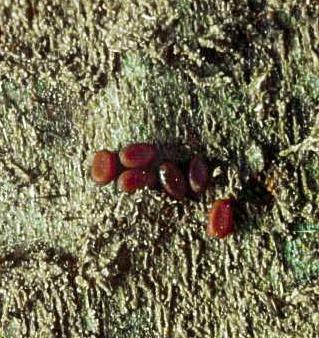peach tree borer eggs
Some adults begin emerging in late May although peak emergence is in mid-to-late August. What does a peach borer look like.

Peach Tree Borer Treatment Control Planet Natural
Once larvae have migrated into the tree insecticides are not effective.

. Most eggs are deposited the day of emergence and mating. Peachtree borer to begin laying eggs in very late June or early July. Most adults emerge and lay up to 500 eggs during July and August on tree trunks in cracks or under bark scales and in soil near the tree trunk.
Adults which resemble wasps are most prevalent from mid-May to early October. Parasitic wasps can help with lesser peach tree borer whose eggs can be found. Peachtree borer is most easily controlled by sprays of insecticides applied to the lower trunk and base of the tree.
The adult moths soon emerge and the females of the peach tree borer lay eggs at ground level on the trunk of the tree in cracks in the ground or on bits of litter while the females of the lesser peach tree borer lay eggs up. During this time eggs are laid on the trunks of trees. The adults mate and lay eggs during July and August.
Females lay eggs on the bark of the tree near the base and the eggs hatch 10 days later. Damage Peachtree borer damage to peach J. Most all eggs will be laid during July and August although a few adults may still be present into September.
It will take about ten days before the eggs will hatch. This will cause damage to large trees and in cases of. Various designs of traps usually with a sticky bottom.
The larvae will crawl to the tree and will find an open bark where it will stay during the winter. The greater peach tree borer is a clear winged moth that lays eggs on the trunk of the tree near the soil line. Grow Tubs Fertilizer Trellises More Gurneys Helps Your Garden Look its Best.
Peach tree borers are serious pests of stone fruit trees such as peaches cherries nectarines apricots and plums. Upon hatching the larvae bore just beneath the bark near the ground level and into the roots to feed on growing tissue and inner bark. This native American borer has been known since colonial times and is a pest wherever peaches are grown.
The peach tree borer moth lays eggs at ground level on the trunk of the tree in cracks in the ground or on bits of litter. Peach tree borers attack near the soil line with most activity occurring a few inches 5 to 75 cm below the ground. Adult peach tree borers dont harm trees directly.
Eggs hatch in 9 to 10 days and the young larvae bore into the bark at the base of the trunk. When temperatures warm up in spring they begin feeding on living inner bark. These are preventive sprays that target the eggs and early larval stages exposed on the bark of the tree.
They continue to feed and grow and transform into a pupa from spring to late July. It has one generation per year. Female Peachtree Borers lay their eggs on the tree trunks or at the base of the tree and lay 500-600 eggs on average.
The lesser peach tree borer moth goes up and down the limbs seeking rough bark or cracks in which to lay eggs. Eggs are 1 50 -inch 05mm ovals reddish-brown and deposited singly or in small groups on the trunk lower limbs or soil. The habitat of the peach tree borer will depend on its specific stage of development.
They are not effective on the pupae of the common greater peachtree borer because theyre under the soil line out of the wasps reach. But certain wasps will parasitize eggs found on bark and just-hatched larvae that have not yet worked their way into the tree. Once beneath the bark they feed in the cambium layer.
These moths simply lay eggs on stone fruit tree trunks. Adult Peachtree borers are a moth that resembles a wasp but they are incapable of stinging and are generally harmless. Eventually the bark begins to peel off damaged areas making the tree susceptible to other pests and disease.
The cycle restarts at this point. Free Shipping Expert Advice. Signs of a Peachtree Borer Infestation.
Damage comes when the moth eggs hatch and new caterpillar larvae travel down trunks and burrow into tree bases and roots disrupting the flow of water and. The eggs hatch and the larvae tunnel into the trunk feeding on the cambium and inner bark. Ad Do-It-Yourself Save.
Females live about 6 or 7 days but lay few eggs after the third day. Tree Fruit Insect Pest - Peachtree Borer. The peachtree borer overwinters survives the winter as larvae.
A way to best determine when adult peachtree borers are locally active is through use of traps. Wounds and rough bark are favorite sites for egg laying. When they are eggs you will find them on the base or trunk of their host tree.
Mature larvae are about 1 1 4 inches 32mm long cream-colored and have brown heads.

Peach And Cherry Insect Pests University Of Maryland Extension

Greater Peachtree Borer In The Landscape Nc State Extension Publications

Lords Environmental Peach Tree Borers

Caterpillars Borers And Miners

Peachtree Borer 5 566 Extension

Goes To Show You Don T Ever Know Plant Pest Advisory
Pests Bc Tree Fruit Production Guide
Eny 691 In489 Peachtree Borers In The Home And Commercial Peach Orchard

Pheromone Lure For Greater Peachtree Borers

Peach Tree Borers How To Control Peach Tree Borers

Peachtree Borer Dummer Garden Manage Gfinger Es La App De Jardineria Mas Profesional
Peachtree Borer Wsu Tree Fruit Washington State University

Peachtree Borer Nc State Extension Publications
Pests Bc Tree Fruit Production Guide
Pests Bc Tree Fruit Production Guide

Peachtree Borer 5 566 Extension

